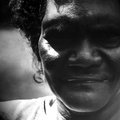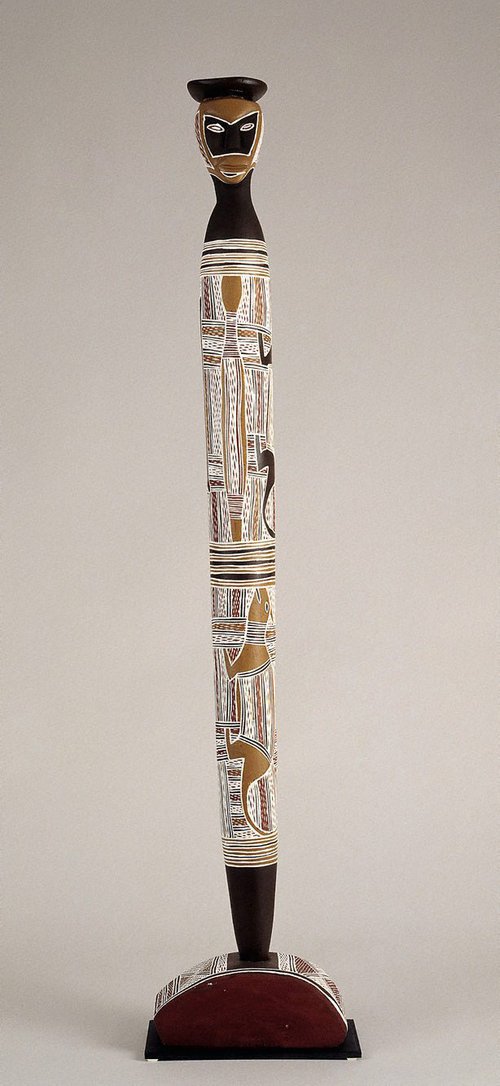Title
Wayawu to Dhuruputjpi
2010
Artist
-
Details
- Place where the work was made
-
Yirrkala
→
North-east Arnhem Land
→
Northern Territory
→
Australia
- Cultural origin
- Djarrakpi, Manggalili, Arnhem region
- Date
- 2010
- Media category
- Bark painting
- Materials used
- natural earth pigments on bark
- Dimensions
- 192.0 x 65.0 cm
- Signature & date
Not signed. Not dated.
- Credit
- Mollie Gowing Acquisition fund for Contemporary Aboriginal art 2014
- Location
- Not on display
- Accession number
- 108.2014
- Copyright
- © Estate of Galuma Maymuru, courtesy Buku-Larrnggay Mulka Arts Centre, Yirrkala
- Artist information
-
 Galuma Maymuru
Galuma Maymuru
Works in the collection
- Share
-
-
About
Galuma Maymuru is the daughter of the renowned Manggalili clan artist Narritjin Maymuru. Maymuru often acted as her father's interpreter and documented the stories in his paintings. Galuma Maymuru grew up at Yirrkala and since 1974 has lived either at the homeland centre of Yilpara or at Dhuruputjpi in her husband Dhukal Wirrpanda's Dhudi Djapu clan country, close to her own Manggalili clan lands. For ten years she was the community's schoolteacher, before becoming a fulltime artist in 1987.
Maymuru's first solo exhibition in 1999 at the William Mora Galleries, Melbourne, was subtitled 'In memory of Narritjin', acknowledging the debt she owed to her father, who taught her to paint and carve. With her father's encouragement, she was one of the first generation of Yolngu women to become major artists. 'He'd say "this is our painting and I'm telling you about the paintings for in the future when I am passed away you can use them"'.She learned by watching Narritjin paint and then worked on small bark paintings herself, practising the techniques '... until my hand got better, putting it into my mind'.
To Maymuru, art is an act of memory and a process of transmission, in which she passes Manggalili law on to new generations of her clan. Equally, it is a spiritual and aesthetic exploration of her homeland.
The art centre documentation for this work states: There are two clan groups represented in this work the artists Mangalili clan and her husband’s Dhud-Djapu clan. The miny'tji (sacred clan designs) is Mangalili freshwater and talks of Noykal the Kingfish, rotting wood ranga (sacred object) under the water and the sacred yoku (corms of the water lily) representing the yothu (children) of the Mangalili fed on by the Bilthu (Rifle fish). The Noykal: Turrum, carangoides emburyi, Kingfish, enters into the freshwater to breed. A strong swimming fish seen seasonally cruising along shore lines are speared by Yolngu. It is a totem for the Mangalili clan.
It is the journey of this fish (up freshwater rivers to breed) that created important ties with the relative clans. Noykal's travelling included a path from Dhonydji to the Wayawu River, passed through Dhulinbuy, a site where the Wangurri clanspeople have settled. At Wayawuwuy, Noykal changed into the hollow log Milkamirri. The sacred design represents the Yoku or lily corm eaten by Noykal whilst at the Wayawu River. He swims up stream towards the sacred rock Dhukurru from where ancestors once stood to spear the big fish.
Noykal people dance, with spear throwers the tail and sacred dilly bag in mouth. The concept of lily bulbs in dillybags has an echo in Mangalili children in the womb. Thus the Wayawu is the freshwater source of Mangalili sounds and an analogy for the Milky Way which is also seen as the reservoir of Mangalili souls from which children spring to select their parents.
This painting depicts in sacred abstraction the corms still attached to the plant, being washed from the lily beds by the flooding Wayawu and represents the Mangalili essence (of Noykal) in this water. The main stream can be seen running though the centre of the work. The Wayawu River also runs through the estate of her Husband. At the old camp starts a massive ground of paperbarks in black mud that floods in the wet. A walk though leads to a large billabong that has been fished since Mana (ancestral shark) and giant barramundi and saratoga lived there.
Looking far up the far bank of more black mud and malaeluca, it eventually curves around out of sight. The actions of Ancestral Shark - Gundunuru were swum in these waters. Dharrangi, a freshwater palm like leaf stands out of the water bank here hiding the domain of Mana. In other holes small (freshwater) sharks are observed in season. This is part of the Dhudi Djapu land, Dharrangi the sacred water weed and freshwater is made sacred by the Dhudi-Djapu design. Yolngu refer to it as Garrinyirri. These two waters stand in a mother-child relationship.
-
Places
Where the work was made
Yirrkala
-
Exhibition history
Shown in 1 exhibition
Galuma Maymuru: The torrent bark paintings and ceremonial, Annandale Galleries, Annandale, 05 Mar 2014–29 Mar 2014



